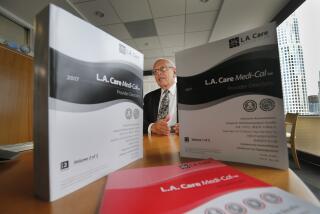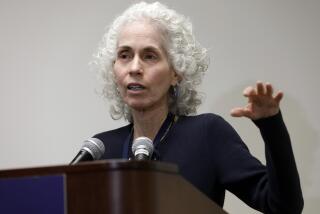Health Care That Works
The patients’ bill of rights, HMO reform and stem cell research filled the headlines last week but not the hallways of the QueensCare Family Clinic in central Los Angeles. Rating health care plans and debating the ethics of the latest medical studies are, after all, luxuries of the insured. For the nearly 3 million Los Angeles County residents without insurance, health care comes down to one question: Where can I find someone to treat my sick child, wife, husband, mother, grandfather when I don’t have enough money to pay?
If a person asking that question finds the Queens-Care clinic, he or she is luckier than most. Partnerships between the county and private, nonprofit clinics like QueensCare have been one of the few good things to come from the county’s health care funding crisis. The problem is that there aren’t enough of the clinics.
For years the county has been caught in a vise. Charged with delivering care to an ever-growing number of low-income residents, it has had no corresponding increase in funding, due to Proposition 13 restrictions and moves by the Legislature that effectively transferred revenue from counties to the state. The Clinton administration rescued the county from near bankruptcy in 1995 by waiving federal Medicaid rules governing outpatient care. When the waiver, extended once, lapses in 2005, the county health department will face a projected deficit of $884 million.
This is one problem that really could be helped by throwing money at it. But it also calls for smarter spending of what funding there is. The waiver encouraged a shift from expensive emergency room treatment--often the last resort for those who have no regular health care--to more cost-efficient care at outpatient clinics. The private-partner clinics have distinct advantages. They do not suffer the reputation of long waits and rude employees that unfortunately clings to county-run clinics. They can supplement county funds with grants. And they are less cumbersome and bureaucratic.
Before the 1995 fiscal crisis, the county had fewer than 50 outpatient clinics. Today it has more than three times that number, with more than 100 of them operated through public-private partnerships. But it’s still not enough to meet the overwhelming need.
Which brings us to the motion made last week by Supervisors Zev Yaroslavsky and Don Knabe to consider putting the county health department under an independent health authority. The skeptics among the supervisors argue that the county’s health care crisis is about money, not governance. It’s about both. Yes, it takes money to open more clinics, even cost-efficient public-private partnerships with willing nonprofit organizations. But to respond to a crisis of this magnitude also takes new thinking and quick acting, not micromanaging by the ever-political Board of Supervisors. Partnering with private clinics was a good start. It’s also a good lesson in what a little independence can accomplish.






